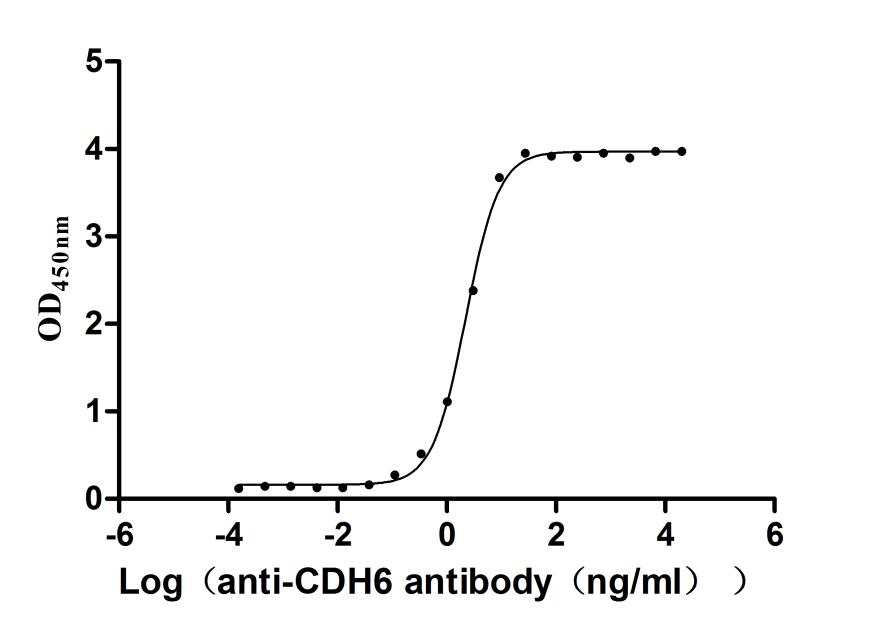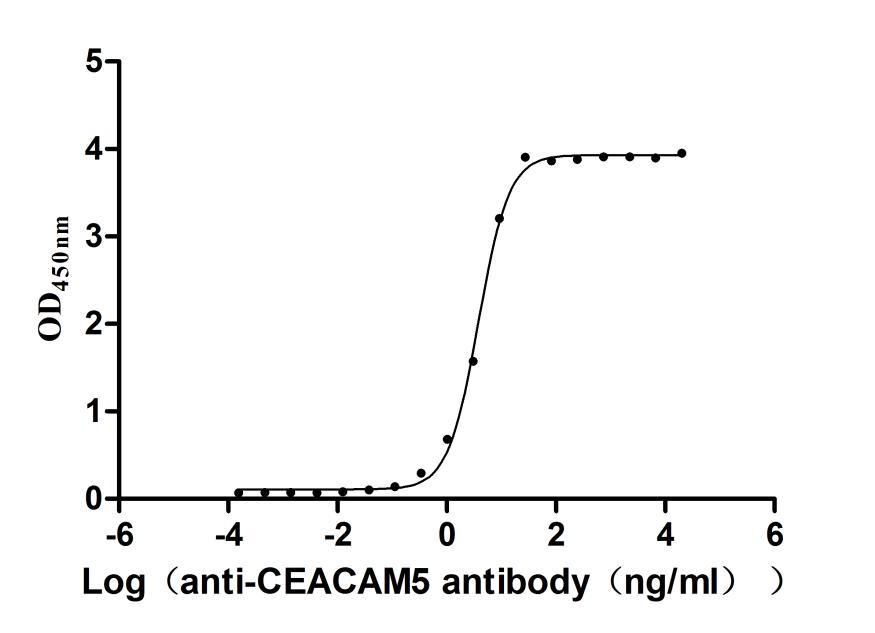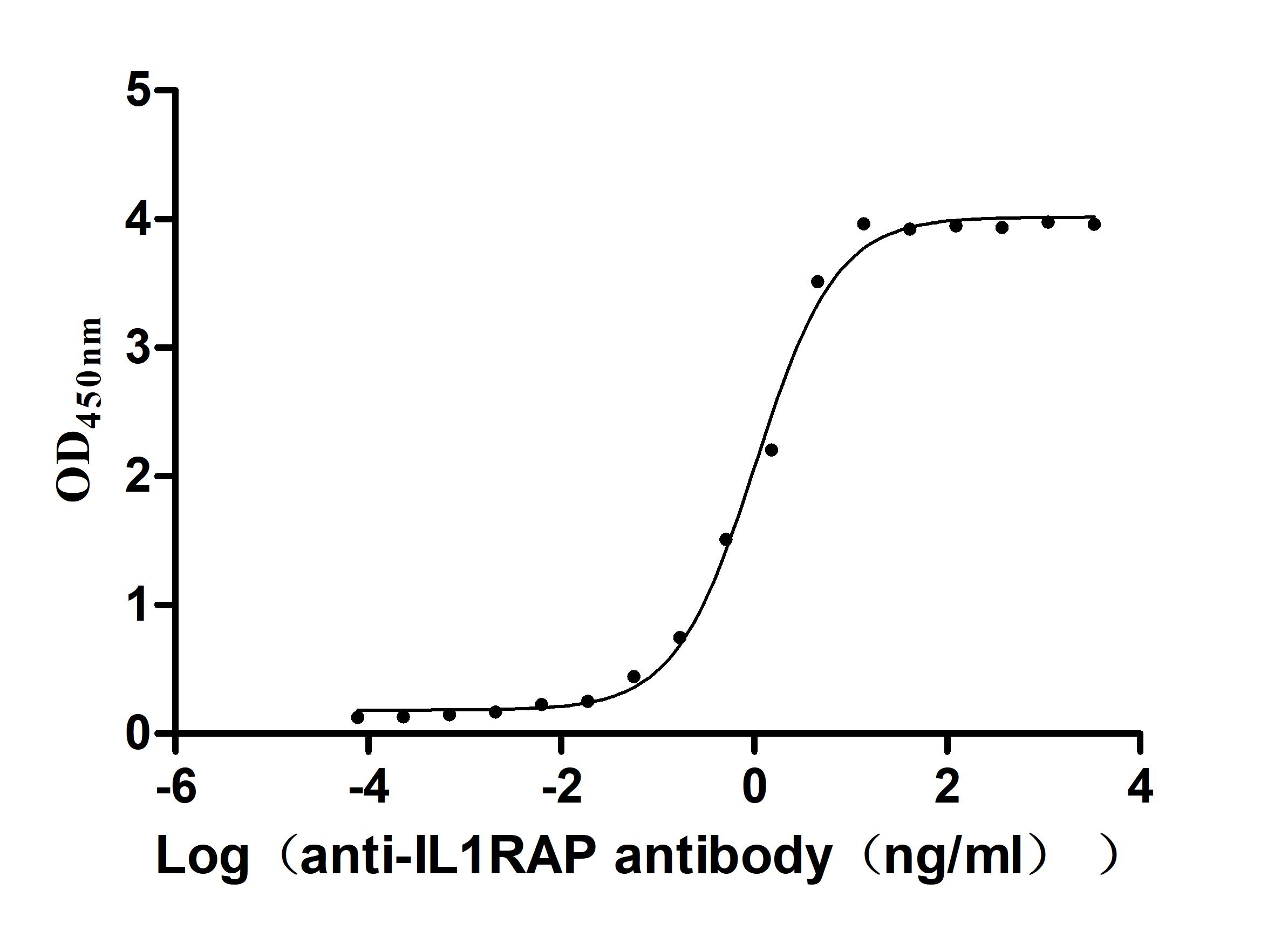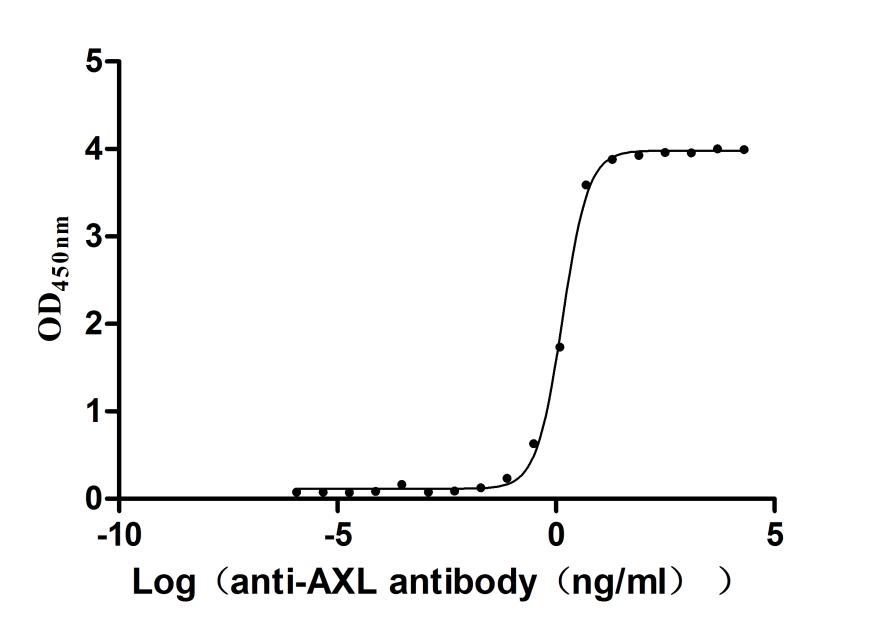Recombinant Mouse Tyrosine-protein kinase Lyn (Lyn)
-
中文名称:小鼠Lyn重组蛋白
-
货号:CSB-YP013259MO
-
规格:
-
来源:Yeast
-
其他:
-
中文名称:小鼠Lyn重组蛋白
-
货号:CSB-EP013259MO-B
-
规格:
-
来源:E.coli
-
共轭:Avi-tag Biotinylated
E. coli biotin ligase (BirA) is highly specific in covalently attaching biotin to the 15 amino acid AviTag peptide. This recombinant protein was biotinylated in vivo by AviTag-BirA technology, which method is BriA catalyzes amide linkage between the biotin and the specific lysine of the AviTag.
-
其他:
-
中文名称:小鼠Lyn重组蛋白
-
货号:CSB-BP013259MO
-
规格:
-
来源:Baculovirus
-
其他:
-
中文名称:小鼠Lyn重组蛋白
-
货号:CSB-MP013259MO
-
规格:
-
来源:Mammalian cell
-
其他:
产品详情
-
纯度:>85% (SDS-PAGE)
-
基因名:
-
Uniprot No.:
-
别名:Lyn; Tyrosine-protein kinase Lyn; EC 2.7.10.2; V-yes-1 Yamaguchi sarcoma viral related oncogene homolog; p53Lyn; p56Lyn
-
种属:Mus musculus (Mouse)
-
蛋白长度:Full Length of Mature Protein
-
表达区域:2-512
-
氨基酸序列GCIKSKRKD NLNDDEVDSK TQPVRNTDRT IYVRDPTSNK QQRPVPEFHL LPGQRFQTKD PEEQGDIVVA LYPYDGIHPD DLSFKKGEKM KVLEEHGEWW KAKSLSSKRE GFIPSNYVAK VNTLETEEWF FKDITRKDAE RQLLAPGNSA GAFLIRESET LKGSFSLSVR DYDPMHGDVI KHYKIRSLDN GGYYISPRIT FPCISDMIKH YQKQSDGLCR RLEKACISPK PQKPWDKDAW EIPRESIKLV KKLGAGQFGE VWMGYYNNST KVAVKTLKPG TMSVQAFLEE ANLMKTLQHD KLVRLYAVVT KEEPIYIITE FMAKGSLLDF LKSDEGGKVL LPKLIDFSAQ IAEGMAYIER KNYIHRDLRA ANVLVSESLM CKIADFGLAR VIEDNEYTAR EGAKFPIKWT APEAINFGCF TIKSDVWSFG ILLYEIVTYG KIPYPGRTNA DVMSALSQGY RMPRMENCPD ELYDIMKMCW KEKAEERPTF DYLQSVLDDF YTATEGQYQQ QP
-
蛋白标签:Tag type will be determined during the manufacturing process.
The tag type will be determined during production process. If you have specified tag type, please tell us and we will develop the specified tag preferentially. -
产品提供形式:Lyophilized powder
Note: We will preferentially ship the format that we have in stock, however, if you have any special requirement for the format, please remark your requirement when placing the order, we will prepare according to your demand. -
复溶:We recommend that this vial be briefly centrifuged prior to opening to bring the contents to the bottom. Please reconstitute protein in deionized sterile water to a concentration of 0.1-1.0 mg/mL.We recommend to add 5-50% of glycerol (final concentration) and aliquot for long-term storage at -20℃/-80℃. Our default final concentration of glycerol is 50%. Customers could use it as reference.
-
储存条件:Store at -20°C/-80°C upon receipt, aliquoting is necessary for mutiple use. Avoid repeated freeze-thaw cycles.
-
保质期:The shelf life is related to many factors, storage state, buffer ingredients, storage temperature and the stability of the protein itself.
Generally, the shelf life of liquid form is 6 months at -20°C/-80°C. The shelf life of lyophilized form is 12 months at -20°C/-80°C. -
货期:Delivery time may differ from different purchasing way or location, please kindly consult your local distributors for specific delivery time.Note: All of our proteins are default shipped with normal blue ice packs, if you request to ship with dry ice, please communicate with us in advance and extra fees will be charged.
-
注意事项:Repeated freezing and thawing is not recommended. Store working aliquots at 4°C for up to one week.
-
Datasheet :Please contact us to get it.
相关产品
靶点详情
-
功能:Non-receptor tyrosine-protein kinase that transmits signals from cell surface receptors and plays an important role in the regulation of innate and adaptive immune responses, hematopoiesis, responses to growth factors and cytokines, integrin signaling, but also responses to DNA damage and genotoxic agents. Functions primarily as negative regulator, but can also function as activator, depending on the context. Required for the initiation of the B-cell response, but also for its down-regulation and termination. Plays an important role in the regulation of B-cell differentiation, proliferation, survival and apoptosis, and is important for immune self-tolerance. Acts downstream of several immune receptors, including the B-cell receptor, CD79A, CD79B, CD5, CD19, CD22, FCER1, FCGR2, FCGR1A, TLR2 and TLR4. Plays a role in the inflammatory response to bacterial lipopolysaccharide. Mediates the responses to cytokines and growth factors in hematopoietic progenitors, platelets, erythrocytes, and in mature myeloid cells, such as dendritic cells, neutrophils and eosinophils. Acts downstream of EPOR, KIT, MPL, the chemokine receptor CXCR4, as well as the receptors for IL3, IL5 and CSF2. Plays an important role in integrin signaling. Regulates cell proliferation, survival, differentiation, migration, adhesion, degranulation, and cytokine release. Down-regulates signaling pathways by phosphorylation of immunoreceptor tyrosine-based inhibitory motifs (ITIM), that then serve as binding sites for phosphatases, such as PTPN6/SHP-1, PTPN11/SHP-2 and INPP5D/SHIP-1, that modulate signaling by dephosphorylation of kinases and their substrates. Phosphorylates LIME1 in response to CD22 activation. Phosphorylates BTK, CBL, CD5, CD19, CD72, CD79A, CD79B, CSF2RB, DOK1, HCLS1, LILRB3/PIR-B, MS4A2/FCER1B, SYK and TEC. Promotes phosphorylation of SIRPA, PTPN6/SHP-1, PTPN11/SHP-2 and INPP5D/SHIP-1. Required for rapid phosphorylation of FER in response to FCER1 activation. Mediates KIT phosphorylation. Acts as an effector of EPOR (erythropoietin receptor) in controlling KIT expression and may play a role in erythroid differentiation during the switch between proliferation and maturation. Depending on the context, activates or inhibits several signaling cascades. Regulates phosphatidylinositol 3-kinase activity and AKT1 activation. Regulates activation of the MAP kinase signaling cascade, including activation of MAP2K1/MEK1, MAPK1/ERK2, MAPK3/ERK1, MAPK8/JNK1 and MAPK9/JNK2. Mediates activation of STAT5A and/or STAT5B. Phosphorylates LPXN on 'Tyr-72'. Kinase activity facilitates TLR4-TLR6 heterodimerization and signal initiation. Phosphorylates SCIMP on 'Tyr-96'; this enhances binding of SCIMP to TLR4, promoting the phosphorylation of TLR4, and a selective cytokine response to lipopolysaccharide in macrophages. Phosphorylates CLNK.
-
基因功能参考文献:
- Fyn and Lyn as important factors that promote Plasmacytoid dendritic cell responses. PMID: 28368000
- these findings demonstrated that Lyn overexpression ameliorated airway mucus hypersecretion by down-regulating STAT6 and its binding to the MUC5AC promoter. PMID: 28205598
- A novel pancancer mechanism of Lyn-dependent control of epithelial-mesenchymal transition and role of this kinase in tumor progression. PMID: 28288135
- these results reveal a role for Lyn as a specific suppressor of the TLR-MyD88-IRF5 pathway and illustrate the importance of fine-tuning IRF5 activity for the maintenance of immune homeostasis PMID: 27521268
- These findings reveal that the function and regulation of Lyn during B1 cell B cell receptor signaling is distinct from other B cell subsets. PMID: 27889108
- A mutation in LYN, an inhibitory protein tyrosine kinase that is implicated in systemic autoimmunity, combines with an Aire mutation to provoke organ-specific autoimmunity. PMID: 27571405
- the Hck, Fgr and Lyn kinases are also necessary for amastigote uptake by macrophages. Src-mediated Arg activation is required for efficient uptake. PMID: 27358479
- the Lyn mutation in NOD neutrophils is likely responsible for dysregulation of neutrophil adhesion and directed migration. PMID: 27591397
- Our studies indicate not only a concept of mucus hypersecretion in asthma that involves Lyn kinase but also an important therapeutic candidate for asthma. PMID: 28024734
- Together, the basal-state signaling checkpoint regulated by LynA expression and degradation and the signaling reorganization initiated by receptor clustering allow cells to discriminate optimally between pathogens and nonpathogens. PMID: 26517880
- Oxidized LDL-bound CD36 recruits an Na/K-ATPase-Lyn complex in macrophages that promotes atherosclerosis. PMID: 26350901
- Lyn kinase modulates inhibitory signaling to suppress endotoxin-induced lung inflammation. PMID: 26453518
- A complex functional interplay between FcgammaRIIa, Lyn, and alphaIIbbeta3 in immune complex-induced platelet activation. PMID: 26291522
- report that Lyn is required for bacterial infection-induced recruitment of autophagic components to pathogen-containing phagosomes PMID: 26735693
- Data indicate interactions between Ets1 transcription factor and two of its important regulators: Lyn, which maintains Ets1 expression to limit the differentiation of autoreactive plasma cells (PCs), and Btk. PMID: 26209625
- results indicate that Lyn plays a positive regulatory role in RIG-I-mediated interferon expression as a downstream component of IPS-1 PMID: 25585356
- Fyn, but not Lyn, was required for complete Pyk2 phosphorylation by thrombin. PMID: 25967238
- Data show that tyrosine protein kinase Lyn acts as a sensor of hydrogen peroxide (H2O2) levels to facilitate microglial migration toward alpha-Synuclein (alpha-syn). PMID: 25825709
- Lyn is a key regulator of survival signaling in plasma cells, limiting plasma cell accumulation and autoimmune disease susceptibility. PMID: 25118329
- Lyn is a key regulator of the mucosal immune system, governing pathophysiology in multiple models of intestinal disease. PMID: 25339668
- The Src family kinases Hck, Fgr, and Lyn are critical for the generation of the in vivo inflammatory environment without a direct role in leukocyte recruitment. PMID: 25225462
- Lyn activity protects mice from DSS colitis and regulates the production of IL-22 from innate lymphoid cells. PMID: 24045577
- analyses revealed a SHP2- and Lyn-dependent pathway leading to phosphorylation of Vav1, Rac activation, and F-actin polymerization in SCF-treated BMMCs PMID: 24733849
- Data (including data from mutant mice) suggest Lyn facilitates erythrocyte production/erythropoiesis by influencing different stages of erythroid progenitor expansion, differentiation, mature cell development, cell survival, and signal transduction. PMID: 24552351
- Data suggest that the tyrosine phosphorylation profile of Lyn in B-lymphocytes is altered in mercury poisoning; Lyn appears to play role as pivotal mediator of mercury immunotoxicity; thus, Lyn is a potential biomarker for mercury exposure. PMID: 24440445
- Lyn regulates inflammatory responses in Klebsiella pneumoniae infection via the p38/NF-kappaB pathway. PMID: 24338528
- the TAG-1-mediated cell-to-cell interaction between the unpolarized multipolar cells and the pioneering axons regulates the polarization of multipolar cells partly through Lyn kinase and Rac1 PMID: 24559674
- B cell-intrinsic Lyn-dependent signaling pathways regulate B cell homeostasis and activation, which in concert with B cell-specific MyD88 signaling pathways can drive the development of autoimmune disease. PMID: 24376269
- regulates TGF-beta3 isoform and modulates the development of airway remodeling PMID: 24127553
- in contrast to c-Src and Yes, which increase vascular permeability in response to stimuli, Lyn stabilizes endothelial junctions through phosphorylation of FAK. PMID: 24108461
- Lyn gene dosage and activity are critical for normal erythropoiesis; constitutively active Lyn alters Epo signaling, which in turn produces erythroid defects. PMID: 23692855
- Data show that the hyperresponsive phenotype of B cells lacking Lyn is predicated on significantly increased basal and inducible PI3K activity. PMID: 22777522
- Chronic inflammation can induce thymic atrophy and perturb spleen homeostasis in LynDeltaN mice through the increased production of TNFalpha, LTss and TNFR1 signaling. PMID: 23071785
- these results indicate that Lyn plays a positive role in TLR4-induced production of TNF-alpha in MCs controlling the activity of the TRAF-6/TAK-1 protein complex. PMID: 22302035
- MLR-1023 increased the V(max) of Lyn with an EC(50) of 63 nM. PMID: 22473614
- Lyn kinase activator MLR-1023-mediated blood glucose lowering was insulin-dependent. PMID: 22431203
- Lyn deficiency disturbs the generation of mature germinal center (GC) B cells and leads to impaired development of mature GCs. PMID: 22942428
- This study demonstrates that Lyn is a haploinsufficient gene in autoimmune disease PMID: 22798664
- Lyn enhances endotoxin-induced dendritic cell (DC) maturation and modified DC cytokine expression profiles, leading to elevated natural killer (NK) cell IFN-gamma production. PMID: 22491248
- Lyn but not Fyn kinase controls IgG-mediated systemic anaphylaxis. PMID: 22450804
- The role of the Src family kinase Lyn in the immunomodulatory activities of cathelicidin peptide LL-37 on monocytic cells PMID: 22246800
- Lyn-deficient T2 and follicular B cells expressed elevated levels of the pro-apoptotic factor Bim. PMID: 21928281
- protein deficiency affects B-cell maturation as well as survival PMID: 22057631
- A model in which PECAM-1/SHP-2 complexes, formed in a Lyn-dependent manner, suppress GPVI signaling. PMID: 21297004
- Despite possessing enhanced killing, alveolar macrophage Lyn/Fgr/Hck-deficient (triple-knockout) mice do not demonstrate enhanced inflammatory responses to Pneumocystis murina. PMID: 21220696
- The results of this study suggested a novel role for Lyn kinase in the regulation of DA release in the mesolimbic system, which leads to the control of alcohol reward. PMID: 21307254
- Lyn- and PLC-beta3-dependent regulation of SHP-1 phosphorylation controls Stat5 activity and myelomonocytic leukemia-like disease PMID: 20858858
- Although Lyn is involved in dampening the cytokine Toll-like receptor response, Lyn-deficient macrophages and mice still develop microbial tolerance. PMID: 20385881
- Lyn B isozyme differs from Lyn A in its association with negative regulatory lipid phosphatase SHIP-1 and in the regulation of calcium responses. PMID: 20308635
- Lyn stimulates platelet secretion by activating the phosphoinositide 3-kinase-Akt-nitric oxide (NO)-cyclic GMP pathway and also provide an explanation why Lyn can both stimulate and inhibit platelet activation PMID: 20189992
显示更多
收起更多
-
亚细胞定位:Cell membrane. Nucleus. Cytoplasm. Cytoplasm, perinuclear region. Golgi apparatus. Membrane; Lipid-anchor.
-
蛋白家族:Protein kinase superfamily, Tyr protein kinase family, SRC subfamily
-
组织特异性:Detected in bone marrow-derived monocytes and macrophages (at protein level). Expressed predominantly in B-lymphoid and myeloid cells.
-
数据库链接:
KEGG: mmu:17096
STRING: 10090.ENSMUSP00000038838
UniGene: Mm.317331
Most popular with customers
-
Recombinant Human T-cell surface protein tactile (CD96), partial (Active)
Express system: Mammalian cell
Species: Homo sapiens (Human)
-
Recombinant Rat Microtubule-associated protein tau (Mapt) (Active)
Express system: Mammalian cell
Species: Rattus norvegicus (Rat)
-
Recombinant Macaca fascicularis lymphocyte antigen 6 family member G6D (LY6G6D) (Active)
Express system: Yeast
Species: Macaca fascicularis (Crab-eating macaque) (Cynomolgus monkey)
-
Recombinant Rat Gastric inhibitory polypeptide receptor (Gipr), partial (Active)
Express system: Mammalian cell
Species: Rattus norvegicus (Rat)
-
Recombinant Macaca fascicularis Cadherin 6(CDH6),partial (Active)
Express system: Mammalian cell
Species: Macaca fascicularis (Crab-eating macaque) (Cynomolgus monkey)
-
Express system: Mammalian cell
Species: Macaca mulatta (Rhesus macaque)
-
Recombinant Macaca fascicularis Interleukin 1 receptor accessory protein(IL1RAP), partial (Active)
Express system: Mammalian cell
Species: Macaca fascicularis (Crab-eating macaque) (Cynomolgus monkey)
-
Recombinant Human Tyrosine-protein kinase receptor UFO(AXL),partial (Active)
Express system: Mammalian cell
Species: Homo sapiens (Human)


-AC1.jpg)

















